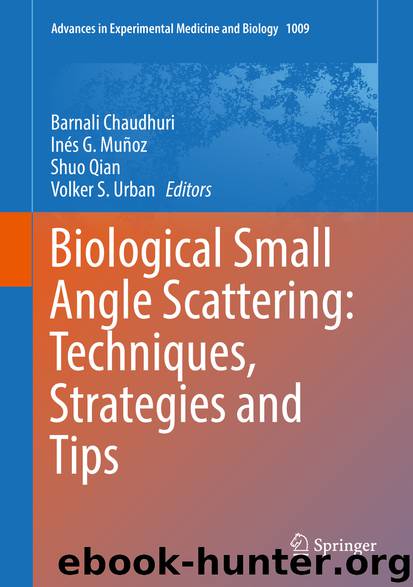Biological Small Angle Scattering: Techniques, Strategies and Tips by Barnali Chaudhuri Inés G. Muñoz Shuo Qian & Volker S. Urban

Author:Barnali Chaudhuri, Inés G. Muñoz, Shuo Qian & Volker S. Urban
Language: eng
Format: epub
Publisher: Springer Singapore, Singapore
8.2 WAXS Data
Collection of WAXS data simultaneously with SAXS data is challenging, even at state of the art beam lines (Zhang et al. 2000; Makowski 2010). It can be accomplished with a very small beam stop and large detector; or by using two detectors set at different sample-to-detector distances, the WAXS detector subtending only a portion of the wide angle region, but capturing enough intensity to provide good signal-to-noise ratio after merging with the SAXS data (e.g., Allaire and Yang 2011). Ideally, one would like to set a WAXS detector on axis and at relatively small sample-to-detector distance, but including a slot-shaped hole to allow passage of x-rays to a SAXS detector placed at a much higher sample-to-detector distance. Choosing a slot-shaped hole would generate a q-range in which data was collected at both detectors, providing adequate overlap for accurate scaling of data from the two detectors. This arrangement has not, as of yet, been implemented.
The scattered intensity, I(q), from a protein solution can be calculated, in principle, from the position of all atoms in the protein using the Debye formula,
Download
This site does not store any files on its server. We only index and link to content provided by other sites. Please contact the content providers to delete copyright contents if any and email us, we'll remove relevant links or contents immediately.
| Automotive | Engineering |
| Transportation |
Whiskies Galore by Ian Buxton(41879)
Introduction to Aircraft Design (Cambridge Aerospace Series) by John P. Fielding(33064)
Small Unmanned Fixed-wing Aircraft Design by Andrew J. Keane Andras Sobester James P. Scanlan & András Sóbester & James P. Scanlan(32743)
Craft Beer for the Homebrewer by Michael Agnew(18140)
Turbulence by E. J. Noyes(7936)
The Complete Stick Figure Physics Tutorials by Allen Sarah(7307)
Kaplan MCAT General Chemistry Review by Kaplan(6867)
The Thirst by Nesbo Jo(6826)
Bad Blood by John Carreyrou(6552)
Modelling of Convective Heat and Mass Transfer in Rotating Flows by Igor V. Shevchuk(6391)
Learning SQL by Alan Beaulieu(6211)
Weapons of Math Destruction by Cathy O'Neil(6143)
Man-made Catastrophes and Risk Information Concealment by Dmitry Chernov & Didier Sornette(5921)
Digital Minimalism by Cal Newport;(5664)
Life 3.0: Being Human in the Age of Artificial Intelligence by Tegmark Max(5474)
iGen by Jean M. Twenge(5366)
Secrets of Antigravity Propulsion: Tesla, UFOs, and Classified Aerospace Technology by Ph.D. Paul A. Laviolette(5309)
Design of Trajectory Optimization Approach for Space Maneuver Vehicle Skip Entry Problems by Runqi Chai & Al Savvaris & Antonios Tsourdos & Senchun Chai(5011)
Pale Blue Dot by Carl Sagan(4912)
